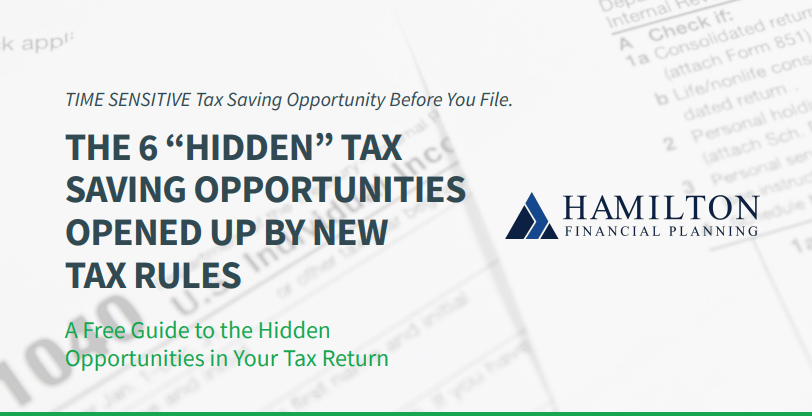
By Scott Hamilton, CFP®
As 2025 draws to a close, it’s the perfect time to tie up loose ends and prepare for the year ahead. One area you don’t want to overlook is your taxes. While taxes may not feel festive, taking proactive steps now can save you money, which is definitely something worth celebrating! Make the most of your financial planning with these year-end tax strategies.
Table of Contents
1. Harvest Your Tax Losses
The IRS allows investors to offset their capital gains with similar capital losses. If you happen to be holding a losing investment, now might be a good time to sell it so that you can use the loss to offset your capital gains (profits taken) for this year and therefore lower this year’s tax bill. Losses over gains in a tax-year may be deductible up to $3,000 and the remainder “carried over” to future years. Be aware of the “wash-sale” rule regarding capital losses if you plan to repurchase the losing investment at a later date.
2. Give to Charities
Contributing to charity can lower your tax bill if you itemize your deductions. And it doesn’t have to be just money that you donate. Clean out your closet and kitchen cabinets and take a box over to your local 501(c)(3) thrift store. As long as they give you a receipt for the donation, you will be able to itemize and deduct whatever the fair market value is for the items. If you donate regularly to charity each year and your total itemized deductions are close to the standard deduction, you might consider bunching multi-year charitable contributions into one tax year, itemizing in that one year and saving on taxes over multiple years. (See Donor-Advised Fund below.)
If you have appreciated stock, you can get an even greater benefit by donating it to charity. You get to deduct the fair market value of the stock as a charitable contribution and the charity is not liable for the capital gains taxes.
3. Open a Donor-Advised Fund
With the higher standard deduction now in place under the One Big Beautiful Bill Act (OBBBA), many of those who are charitably inclined are considering donor-advised funds. Donor-advised funds work as charitable giving savings accounts where you get a deduction when you put the money into the fund, not when you distribute it to a charity.
If your itemized deductions are close to the standard deduction, you can open a donor-advised fund and put a large sum of money into it in 2025. You get to take the tax deduction for this year but hand the money to charities over time. Then, in 2026 and afterwards, you may not have deductions for your charitable giving, but you can still take the standard deduction. (1)
4. Take Your Required Minimum Distribution (RMD) and Consider a Qualified Charitable Distribution (QCD)
You are required to take minimum distributions from your retirement accounts (except Roth IRAs) by April 1st the year following your 73rd birthday. After that, the money must come out of your account by December 31. If you’re charitably-inclined, you can use the qualified charitable deduction strategy and donate the RMD directly to a charity of your choice up to $108,000. The charitable deduction offsets the taxable distribution for tax purposes.
5. Max Out Your Retirement Account
Another way to lower your income, and therefore your tax bill, is by deferring that income until retirement. In 2025, you can contribute up to $23,500 to a 401(k) plan, which will remove that money from your current taxable income. If you are 50-59 years old or 64 and over, your yearly contribution limit goes up to $31,000. Those aged 60-63 are entitled to a “super catch-up” contribution where their total maximum is $34,750. You can put up to $7,000 in any type of IRA; $8,000 if you are over age 50.
6. Convert Your IRA
If you have lower income than normal in 2025, then it might make sense to convert your traditional IRA to a Roth or even do a partial conversion. In doing so, you would pay the income taxes on the money now, at your 2025 rates, so that you could take all withdrawals tax-free in retirement.
Another benefit of having your money in a Roth account is that it is not subject to required minimum distributions as discussed above. Once your money is in a Roth IRA, you can leave it in there to grow as long as you’d like.
7. Take Advantage of Your HSA
If you have access to a health savings account (HSA) with your high-deductible health plan, you can enjoy triple-tax savings with no federal income tax, no state or local taxes, and no Federal Insurance Contribution Act (FICA) taxes. Your contributions are tax-deferred and withdrawals are tax-free for medical expenses.
Since your balances roll over from year to year, you can max out the account without worrying about using it up right away. For 2025, the contribution limit is $4,300 for an individual and $8,550 for a family, with a $1,000 catch-up bonus for those over 55.
8. Prepay Tuition
If you have a college student, consider paying next term’s tuition before December 31. Any tuition you pay for the first four years of undergraduate study is eligible for the American Opportunity Tax Credit, subject to income eligibility limitations. This credit may save you up to $2,500 per student on your tax bill depending on your expenses and income. If you are the one doing the studying, you may be eligible for the Lifelong Learning Credit.
9. Contribute to a 529 Plan
If you’re still working on saving for your children’s college education, then you may benefit from putting some money into a 529 plan before the year’s end. This won’t help with your federal tax bill, but it might lower your state taxes. Many states allow deductions for contributions to the state’s 529 plan and some even allow them for contributions to other plans.
10. Reach Out Today for Support With Year-End Tax Strategies
Even during the holiday season, there are smart actions you can take to optimize your taxes before year-end. Implementing the right year-end tax strategies now can help reduce your tax burden and position your finances for success in the coming year. If you want help putting these strategies into practice or learning more about how we support our clients, schedule a complimentary get-acquainted meeting online or reach out to us at 512-261-0808 or scott@hamiltonfinancialplanning.com.
About Scott
Scott Hamilton is founder and chief financial officer at Hamilton Financial Planning, a wealth management firm that specializes in providing comprehensive financial planning for retirees. With over 20 years of experience in the financial industry, and having completed over 250 financial plans for retirees across all industries, but mostly the oil and gas industry, Scott is passionate about providing his clients with the tools and insight they need to achieve their financial goals. He has a Bachelor of Business Administration in finance from Texas State University and an MBA in international finance from Pepperdine University. Scott has also been happily married to his wife, Gayle, for over 25 years. To learn more about Scott, connect with him on LinkedIn.
_________________________
(1) While donor-advised funds have many advantages, some disadvantages to be aware of include but are not limited to possible account minimums, strict limits on grant allocations, management fees, and the potential that future tax laws may change at any time that may impact the tax treatment and benefits of donor-advised funds.

